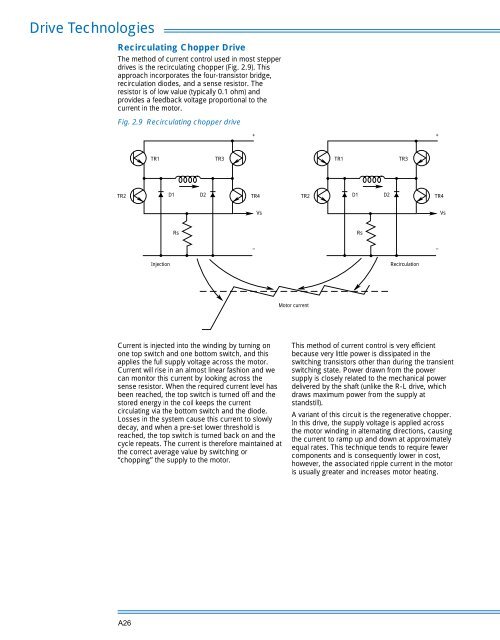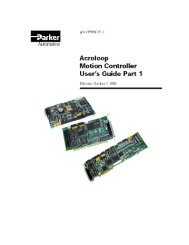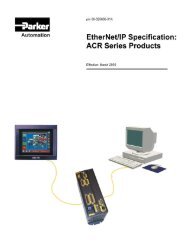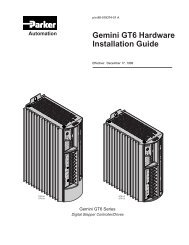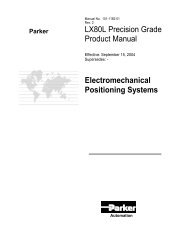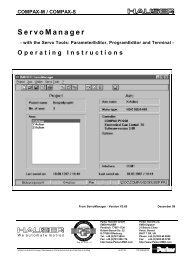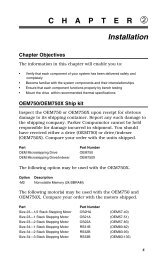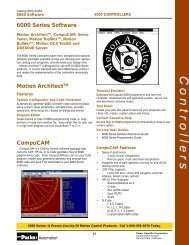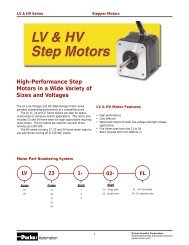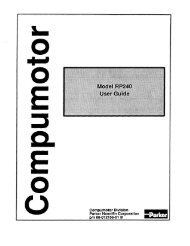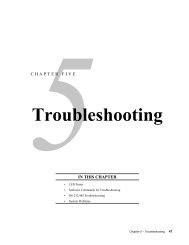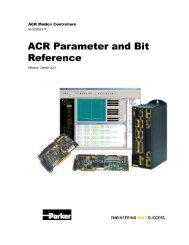Compumotor Step Motor & Servo Motor Systems and Controls
Compumotor Step Motor & Servo Motor Systems and Controls
Compumotor Step Motor & Servo Motor Systems and Controls
You also want an ePaper? Increase the reach of your titles
YUMPU automatically turns print PDFs into web optimized ePapers that Google loves.
Drive Technologies<br />
Recirculating Chopper Drive<br />
The method of current control used in most stepper<br />
drives is the recirculating chopper (Fig. 2.9). This<br />
approach incorporates the four-transistor bridge,<br />
recirculation diodes, <strong>and</strong> a sense resistor. The<br />
resistor is of low value (typically 0.1 ohm) <strong>and</strong><br />
provides a feedback voltage proportional to the<br />
current in the motor.<br />
Fig. 2.9 Recirculating chopper drive<br />
+ +<br />
TR1<br />
TR3<br />
TR1<br />
TR3<br />
TR2<br />
D1<br />
D2<br />
TR4<br />
TR2<br />
D1<br />
D2<br />
TR4<br />
Vs<br />
Vs<br />
Rs<br />
Rs<br />
– –<br />
Injection<br />
Recirculation<br />
<strong>Motor</strong> current<br />
Current is injected into the winding by turning on<br />
one top switch <strong>and</strong> one bottom switch, <strong>and</strong> this<br />
applies the full supply voltage across the motor.<br />
Current will rise in an almost linear fashion <strong>and</strong> we<br />
can monitor this current by looking across the<br />
sense resistor. When the required current level has<br />
been reached, the top switch is turned off <strong>and</strong> the<br />
stored energy in the coil keeps the current<br />
circulating via the bottom switch <strong>and</strong> the diode.<br />
Losses in the system cause this current to slowly<br />
decay, <strong>and</strong> when a pre-set lower threshold is<br />
reached, the top switch is turned back on <strong>and</strong> the<br />
cycle repeats. The current is therefore maintained at<br />
the correct average value by switching or<br />
“chopping” the supply to the motor.<br />
This method of current control is very efficient<br />
because very little power is dissipated in the<br />
switching transistors other than during the transient<br />
switching state. Power drawn from the power<br />
supply is closely related to the mechanical power<br />
delivered by the shaft (unlike the R-L drive, which<br />
draws maximum power from the supply at<br />
st<strong>and</strong>still).<br />
A variant of this circuit is the regenerative chopper.<br />
In this drive, the supply voltage is applied across<br />
the motor winding in alternating directions, causing<br />
the current to ramp up <strong>and</strong> down at approximately<br />
equal rates. This technique tends to require fewer<br />
components <strong>and</strong> is consequently lower in cost,<br />
however, the associated ripple current in the motor<br />
is usually greater <strong>and</strong> increases motor heating.<br />
A26


